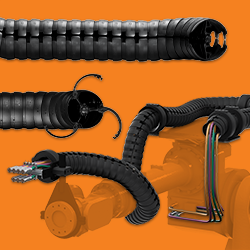6 Emerging Trends in Marine Robotics

Recent innovations are transforming the field of marine robots. Aquatic robotics is already a cutting-edge sector, taking complex technologies and applying them to underwater tasks.
These emerging trends are shaping the future of marine robotics. An exciting variety of innovations are powering today’s advancement, from renewable energy to biomimetic engineering.
1. Skipperless Ships
While driverless cars take to the roads, engineers are designing skipperless ships for autonomous voyages at sea. These vessels could greatly improve the shipping industry. AI-powered boats could potentially be safer and more efficient than human-operated versions.
They would also be lighter and smaller since there would be no need to accommodate a human crew. Autonomous ships may even help reduce supply chain congestion due to the lack of personnel needed to get the vessel from one place to another.
Engineering and technology companies are already developing autonomous ships. Rolls-Royce made headlines in 2019 when it announced it would be spearheading such a project. The propulsion company even built and tested a ferry that was put on display for dignitaries in Finland. Autonomous ships like this are a unique niche of marine robotics because they have the potential to change transportation, from public transit to global supply chains.
2. Hull Cleaning Robots
One of the biggest problems in the shipping industry is invasive species that impact everything from military vessels to cruise ships. Hulls tend to accumulate debris as they move through the oceans, including some live creatures that form colonies.
When the ship docks in a new port, it risks introducing this species to an ecosystem it doesn’t belong in. This is known as biofouling. In fact, the invasive species problem has gotten so bad that New Zealand has strict anti-biofouling regulations for ships arriving in its ports.
In response to this issue, hull-cleaning robots have become a major trend in marine robotics. Usually, cleaning a hull requires a ship to be dry-docked, and the process can take days or even weeks to complete. Too many boats are in high demand today to allow for these expensive delays. Hull-cleaning robots are the perfect solution. They can be remote-controlled or autonomous and usually use a magnet system to stick to the side of the hull. The robot scrubs away debris throughout a ship’s voyage to prevent biofouling.
3. Pollution Cleaning Robots
Water pollution is one of the most pressing environmental issues today. Marine robotics engineers are taking action to find a solution. Chicago startup Urban Rivers has developed a machine called the Trash Robot that can be remotely controlled by anyone worldwide. It swims around rivers in the Chicago area, collecting trash and removing it from waterways.
Marine robots like this are an important trend in robotics and environmental technology. Water pollution is a major public health problem in many areas of the world. Rivers and waterways could be cleaned efficiently and inexpensively with machines like these. This would help local ecosystems as well as whole communities of people.
Some engineers and designers are even working on making pollution cleaning robots solar-powered so they can be fully autonomous and independent. This reduces the need for expensive charging infrastructure, which makes the machines more accessible in poor, impoverished or remote areas.
4. Human-Inspired Marine Robots
Marine robotics is taking cues from the natural engineering of the human body. Scientists know that exercising underwater, whether through scuba diving, swimming in a pool, or using already existing underwater technology, has some great health benefits and may have even helped improve the evolution of human physiology. However, some underwater environments are simply not safe for people to dive to. Below a certain depth, divers risk injury from the intense water pressure alone.
However, the human body is designed in a way that’s ideal for underwater exploration. Marine robotics engineers are applying the advantages of human physiology to a robot that can stand up to extreme conditions. Stanford University made headlines in 2016 with its now-famous humanoid marine robot, OceanOne.
It recovered long-lost treasures from the wreck of a ship that sank in 1664 off the coast of France. Marine robots like the OceanOne could help scientists study deep-sea marine life, explore more fascinating shipwrecks, and potentially even aid in ocean safety and conservation efforts.
5. Underwater Robotic Grippers
Marine mechanical maintenance is in high demand, from ships to offshore drilling vessels. Unfortunately, it is extremely difficult for humans to dive underwater and perform this maintenance, especially on a regular basis. It’s expensive and complicated, and it’s highly dangerous for teams who are difficult to replace due to their specialized skill set.
As a result, submersible robots and robotic grippers are becoming extremely popular in marine robotics. The automated tools completely change the underwater maintenance process, making it safer, more affordable and far more efficient. Underwater grippers are their own unique niche in marine robotics.
These devices are already complex enough, but adapting them to work effectively and precisely underwater adds a completely new level of complexity to the design challenge. Underwater maintenance robots need to be able to operate tools and effectively work with potentially small objects like screws and bolts. Advancements in underwater motor technology are major innovations for the robotics industry as a whole.
6. Biomimetic Underwater Robots
In addition to marine robots inspired by humans, more aquatic robots are emerging that are inspired by ocean wildlife. Biomimetic engineering takes inspiration from the natural world, using the evolutionary engineering of real plants and animals to improve next-gen marine robotics. This is especially useful because propulsion and motor skills are much more difficult underwater than they are on land.
A team of researchers at the University of Southampton and the University of Edinburgh have developed a fascinating flexible robot with a unique, squid-inspired propulsion system. Squids and jellyfish are among the most efficient swimmers in the world’s oceans.
An artificial replica could potentially allow marine robots to be less disruptive to the ecosystems they explore. In fact, the universities’ team found that this system was up to 50 times more efficient than traditional underwater robot propulsion methods.
Powering the Future of Marine Robotics
Marine robotics is an exciting and fascinating field, constantly alive with innovation. These emerging trends represent the future of the marine robotics industry. In fact, these technologies could potentially transform many other sectors, as well.
Cutting-edge advancements are helping people worldwide keep the oceans clean, protect ecosystems, work more safely and even explore new regions of the underwater world.
Comments (0)
This post does not have any comments. Be the first to leave a comment below.
Featured Product

